As a citizen and member of the larger community, the meddlesome pundit does have a legitimate interest in the fate of heritage buildings.
By Shawn Selway
Published February 07, 2013
It is contrary to the interests of public policy if contractors, like feudal barons of ancient times, are permitted to have responsible public servants posturing as if they were personal lackeys.
-- City Solicitor Ken Rouff, 1971, in a submission to the judge conducting the inquiry into the construction of Hamilton City Hall, cited in Freeman and Hewitt, Their Town.
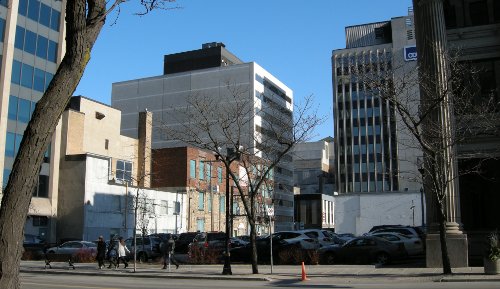
Blanking. East side of James between King and Main. Wasn't there a building here, not too long ago? I can't quite remember...
Last October, David Blanchard, (Wilson Blanchard), having acquired most of the block bounded by King, Main, James, and Hughson streets, including the Union Gas building and the HSBC bank, as well as 18-28 King on the Gore, announced his firm's intention to build something or other there.
Mr. Blanchard's firm naturally wishes to maximize the square footage available for its projects, and the price at which that footage can be sold or leased. The latter is determined by location and design and the income of potential tenants.
In order to increase footage or attract preferred tenants, it is not clear which, Wilson Blanchard wants to remove 18-28 King. This proposal has provoked strong resistance from the growing numbers of Hamiltonians who wish development to occur without further loss and degradation of the existing building stock.
Mr. Blanchard was putting up a trial balloon -- the second of Operation Gore. The first was the shotgun alley he ran through at 30 King Street East in May 2011. Although the building was registered by the City on its Inventory of Buildings of Architectural and/or Historical Interest, Wilson Blanchard had no trouble obtaining a demolition permit.
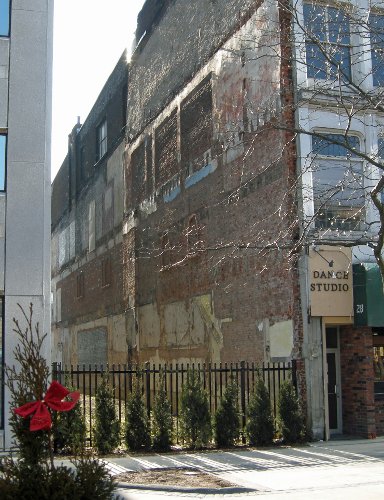
Missing tooth
Whatever might become of the rest of the dominos in this row, the gap at 30 gave access to the core of the block from King Street. (It would be interesting to know who owns the alley in the rear, as it is obviously of importance to servicing the buildings on the Gore in that block.)
Floating the demolition of 18-28 is causing a good deal more turbulence, but as it stands today Blanchard Wilson is close to being rid of 24 and 28. He will be able to deal with 18, 20, and 22, which remain unprotected, at a later date - presumably when there are spiffier renderings and firmer plans for the condos which he wants to sell into an implausibly crowded market that includes the Connaught and the Vranich buildings under construction on Main.
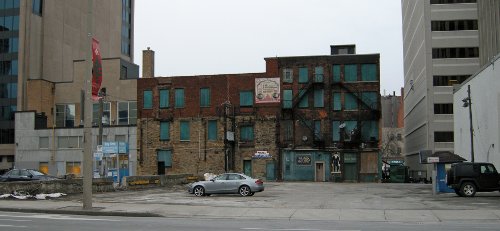
18-28 King rear ie looking north from Main Street. Bank of Nova Scotia to the left, HSBC on the left.
What has been most interesting in this episode is that the developer seems prepared to engage in a discussion which the city seems unwilling to have. In fact, even taking Mr Blanchard's words with the scepticism due to a developer's public pronouncements, city staff has appeared more eager to demolish than to explore possibilities with he and his architect.
The City of Hamilton does not owe Blanchard Wilson any particular rate of return on their real estate speculations. However, the City does have a duty not to devalue Mr Blanchards's property by, for example, allowing a building contractor to deposit truckloads of dirt in Gore Park.
Council also has a responsibility to protect and transmit the best of the past, and a representative sample, to the future.
And if the community insists on their interest in the cultural landscape, and persuades their representatives to act upon it, then the community may also wish Council to pony up some cash -- on the principle that is unfair to impose new obligations without also providing some means to meet those obligations.
The key word here is new. Mr Blanchard knows very well the significance of the Gore, and the possibility that some or all of those buildings could be designated, and surely has reckoned with the implications.
The fact is, the City and the Province have what amounts to a lien on properties in a historic district like the Gore, through the provisions of the Ontario Heritage Act.
If he were unable to demolish, Mr. Blanchard would just do business as usual, and distribute the costs of renovating the historic buildings, along with all his other costs, among the eventual tenants of whatever project he realizes on the parcel.
The Gore has been extremely important in the life of Hamilton, not only as a ceremonial site and public amenity but also commercially, and these uses are tightly intertwined. Even the fountain (1859, 1996), sponsored by a bank, was installed not only as an ornament but as an advertisement.
The builders of the first waterworks wanted to make a display of a crucial economic asset: clean, pressurized running water. Before the reservoir on the side of the mountain was even connected to the pumphouse, the city fire brigade hooked their hoses to the new mains and shot water over a four story building.
The commercial message: build your hotel or factory here, and when your neighbour's building catches fire, we will put it out before yours goes with it.
Gore Park fountain advertised a comparative advantage. It still does. Almost everyone has clean running water and a fire service now, but few have anything comparable to our stock of historic buildings coupled with our lakeside situation, and no other town in southern Ontario has a feature like the Gore.
In addition to its duty to protect cultural resources, Council also has responsibilities toward the environment. No building should go to the dump before a very close comparison is made in terms of lost materials and embedded energy. (No, it is not the case that all new structures are more energy efficient than all old ones.)
Not demolition but adaptive reuse is the responsible default position, whether the building is of historic or architectural importance or not. However, preservation and adaptive re-use are not always complementary. They can conflict, and as it happens a Blanchard building serves as a very good example of the problem.
The Spectator, approving the demolition of 24 and 28 King but with reservations (Compromise on Gore plan is a win-win, Jan 17 2013) reminded its readers that
"Blanchard has, in the past, demonstrated his commitment to preserving Hamilton's heritage, through his involvement in the redevelopment of the Piggot, Landed Bank and Gowlings buildings."
(Gowlings is the former Bank of Montreal 1929.) Not mentioned is 1 Hunter East (1954, 2007), formerly 74 Hughson South, also a Blanchard Wilson effort and by no means a work of preservation; indeed, it was an alteration so drastic as to obliterate the previous building.
I introduce this not to diminish Mr. Blanchard's reputation for thoughtful stewardship of historic properties, which is irrelevant anyway: keeping one building or ten does not give you a license to destroy the next one. Rather, the treatment of 1 Hunter shows how sharp a conflict can arise between the adaptive re-use of a building and the preservation of its historic integrity.
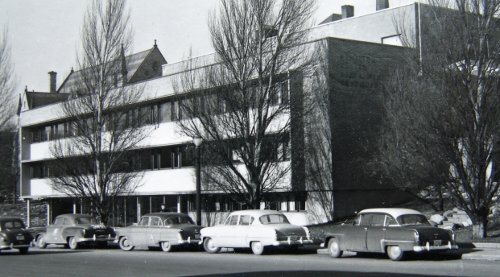
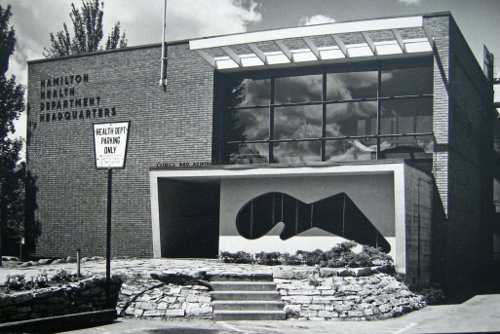
Hamilton Health Department,74 Hughson Street South, c.1954 Source: HPL Local History and Archives.
Designed by the city architect, Stanley Roscoe, for the City's Public Health Department and completed in 1954, it is essentially a steel frame supporting floors of highly finished prefabricated concrete slabs and sheathed in brick ie an early instance of the modular approach that is now the standard for low-rise non-residential construction.
It was equipped with roll-away cabinetry and furniture, some new and some rehabilitated. The dental chair was "refurbished with some new parts, fresh upholstery and a coast of green paint. The latter was a $300 job...A new dental chair costs $800. Then there is the old examining table rejuvenated by an automobile shop by a thorough scraping and a new coat of gleaming white enamel --and finally dressed up with a foam rubber cover." (Spectator June 5 1954)
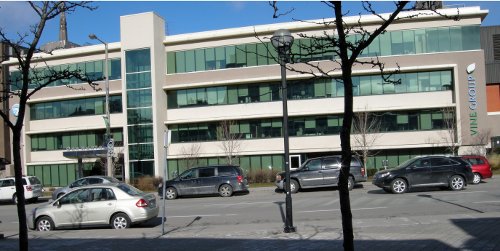
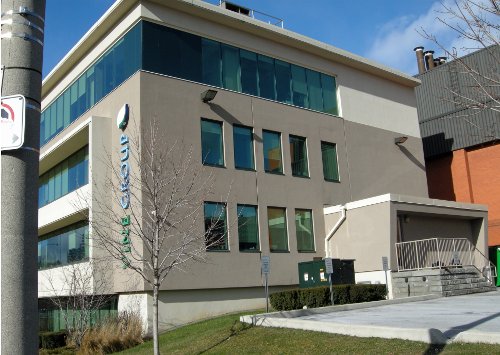
1 Hunter Street East.
This building sat empty for some years before receiving its current form in 2007, which differs greatly from the original. A new floor was added, and many other changes were made to the facades. Had this building been designated, with the consequent requirement of approval for alterations, the east elevation, which was the main entrance as built, would certainly have appeared on the list of elements of significance, and its complete removal would not have been approved. Similarly the insertion of the elevator shaft in the south elevation, which would likely have been moved to the rear.
If we had this building as it was, across from the GO station (former TH&B 1933, 1996) along with the Ed Centre (1966) across from the City Hall (1960, 2010), we would have an interesting set of modernist institutional buildings of all scales, to go along with the wonderful set of modernist houses that were featured in the Sleek shows (Crawford, Butler, Tessier, 2010, 2012) lately mounted at History and Heritage.
We would have, in short, a richer cultural landscape, interesting and instructive not only to us and our children, but to newcomers and visitors as well.
On the other hand, the Hamilton Health building did not go to the landfill, and as an adaptive reuse which was also a re-design of the building, this seems successful. (Personally, I like the glass elevator shaft with its exposed mechanisms quite a lot.)
The land is in use and presumably the developer is making money. But new problems will arise down the road, when, about 2035, the choice to adapt, restore or demolish comes around again.
Would we insist this thing be kept as an example of early 21st century rehabilitation as well as mid-century modernism? Maybe restore? But what is going on under that stucco? Is there a parting layer between the styrofoam and the brick, or was the insulation laid on with an adhesive, in which case the brick face is coming off with it. And so on...
Was the rehab the best choice? Preferable might have been the upgrade of services but retention of the historic exterior details, which are in the public space, but with the addition of the extra floor to increase income.
But then would we have an occupied building, or any structure at all on this corner? The point is, every case must be considered in detail and on its merits, and it is not easy to get the right mix.
Similarly with those buildings on the Gore.
It is absurd to accept that century-old buildings (160 years old in one instance) be discarded without thorough investigation and careful thought. Where is the diligence due to buildings of this age and prominence on the part of staff and Council?
A couple of meetings, a casual acceptance of the developer's statements, and done. Not even a requirement for documentation of these structures. Again, these remarks are made not to denigrate Mr. Blanchard or his architect, but rather to urge a process adequate to the importance of the decision.
Designation under the Heritage Act is not a blunt instrument that kills change and development- it is a management tool, meant to control alterations, not stop them.
But it is not always the best tool, because it places another level of administration between the start and the end of a rehabilitation effort, and paperwork costs time and money.
The result in Ontario has been that larger projects in the built-up areas often pair an architect with a heritage architect, whose task is to ensure that retrofits are compatible with the heritage character of historic buildings, and to obtain the required permissions to achieve what the owner wants to achieve with the property.
Another approach is to do pretty much the same but less formally, which is more flexible but also riskier, and I believe that this is what Mr. Blanchard is signalling. Don't designate, tell me what you care about and I'll see...
To which the reply should be, alright, we'll put a third-party expert on it to see what's of "commemorative significance", as the term is, and get back to you; but if there's no deal, we designate.
This kind of deal, however, requires three-cornered trust, between the proponent, the City, and the community, and this does not exist in Hamilton. It does not exist, in my opinion, because Planning and Economic Development are not working to build it.
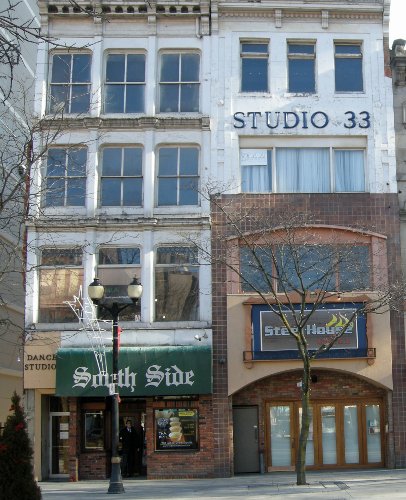
24, 28 King. Much altered?
Here are a few of the items emerging from published comment on 18-28 King which really require more investigation.
Mr. Blanchard told the Spectator (24 Oct 2012), that "the King Street strip has been altered too many times over the years to be of major historical value..."
That a building has been modified over its history does not in itself disqualify the structure from conservation. It is a fact which enters with others into the overall evaluation. It is a professional opinion, to be tested by another.
Further, Mr Blanchard told the Spec, "the buildings along the park are structurally unsound and architecturally difficult to handle. Each one is long, narrow and dark.
"They're like bowling alleys. It's a nightmare," Blanchard said."
Structurally unsound? If so, it is certainly not apparent from the outside.
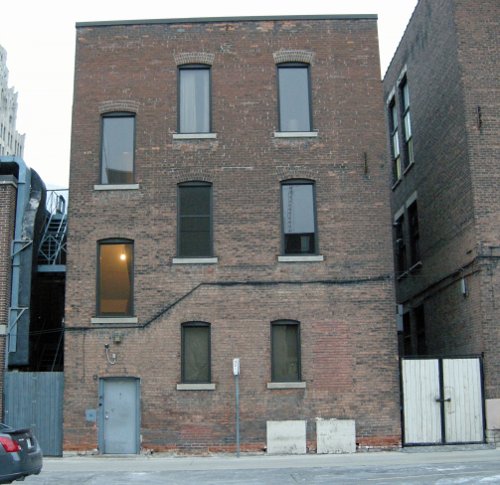
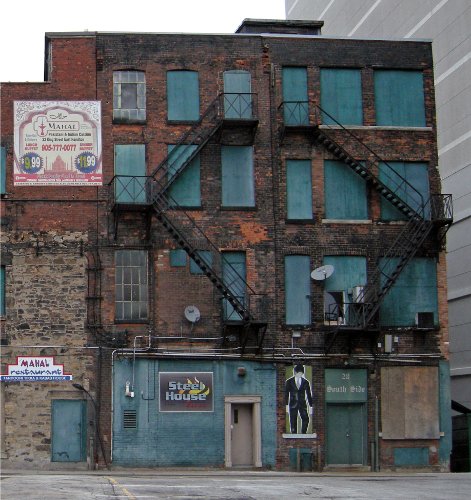
Above, the rear of the Hamilton Club. The gap to the left allows the fire escape to be placed unobtrusively. Below, the rear of 26 and 28 King. There is mortar loss but no obvious movement here, no arches coming out above the windows. Note the repair on the right corner second storey.
Architecturally difficult to handle? Those who have renovated comparable structures on James North say that no, these long, narrow buildings are easy to rehabilitate just because they are so structurally simple - thick brick walls with short, heavy joists spanning a narrow space.
Sean Burak offers pictures and more detail on this point of view in a recent piece for Hamilton Magazine.
Mr Blanchard also permitted the Spectator's photographer to take pictures from a roof of the interior courtyard behind the Thomas building, which functions as a light well in the centre of the complex.
This is an intriguing feature. Was the courtyard integral to the original building? Or a consequence of a later addition? Judging from the stonework, integral. But in either case, it may be worthy of preservation along with the facade. The matter should be investigated by someone with the appropriate expertise.
But also, that courtyard surely has implications for those long dark buildings that their owner is complaining about. Might it be possible to open to from the gap formerly occupied by the demolished 30 King, or from the rear alley?
Of course, such suggestions from uninvested bystanders are meaningless: any sidewalk pundit can conjecture whatever they please. Or, as Mr. Blanchard put it to the Globe and Mail:
There are all kinds of people running around, they're doing their thing, trying to tell us what to do... We'll talk to them. I don't know what good it's going to do and I don't know who's going to pay for it, but we'll talk to them.
But as a citizen and member of the larger community, the meddlesome pundit does have a legitimate interest, and it is set out in the Ontario Heritage Act, the building code, the Official Plan and elsewhere.
With apologies to the councillors who have stepped up, that legitimate public interest is not being adequately asserted at the moment. There is something wrong here.
Mr Blanchard is representing himself as amenable to discussion but the City is not negotiating. Why not?
It is because demolition, regardless of historic or architectural value, is considered the default option at City Hall - a situation which is potentially very costly in the long term, and which we will look at in the next part of this series.
By Joanna (anonymous) | Posted February 07, 2013 at 22:25:37
It's terribly sad. I reviewed the Dec 4th planning meeting 2012
Where councillor Far speaks of these buildings some but not all of them will be coming down. That discussion occurred in planning but again the Permit was then applied for before the Heritage committee could get it on the registry. Given that Hamilton's contribution to heritage designation has totaled 0 for the last 3 years and the way the Mayor currently speaks of Heritage causing issues for developers it wont suprise me to see many more developers or the city knocking over buildings like this and Sanford as an easy way to get'er done.
I personally am disgusted by the lack of care for process and the lack of dignity the city provides these buildings and the people who cherish them. Give us a break already and have a little respect for these fine pieces of history.
I submitted for an FOI on The demolition for Sanford school. I received the applications but none of the required attachments. I'm about 8 emails and 2 phone calls in to this discussion and have now been redirected back to the start of the chain. No one is offering up these documents. The demo permit itself on Sanford was erroneous in that it was to demolish a 2 story building which would under the building code allow them to demolish without the presence of an on site engineer.
They altered to the permit to reflect my concerns etc., rather than revoking it and beginning over which was at the discretion of the Chief building officer.
I wish you well but I do suggest you spend 15$ and get the permit as well as filing an FOI on the application and related documents.
Studio 33 is my favorite Gore building.
By seancb (registered) - website | Posted February 08, 2013 at 12:05:32 in reply to Comment 86033
This issue is not getting nearly as much attention as it deserves.
This is not about a handful of buildings.
The way council handles this case will set a path for the downtown which could result in years of stagnation.
Why?
Let's say Blanchard gets his wish - some or all of the buildings come down, he gets a property tax credit, and he starts trying to sell the parcel to a developer (or tries to acquire the rest of the block).
What message does that send to other landowners on the gore, and in downtown in general?
What will happen is that the speculators on other properties will hold on even tighter and hold out for even more money. They will see that the city will not put up a fight over demolition. They will stare longingly into the dream of a condo-building saviour to swoop in and make them rich.
This will essentially take all of the other properties on the gore off of the table for adaptive reuse and small scale development. It could also start a wave of more demolition permits as landowners clue in to the fact that the city can be held hostage over the destruction of heritage buildings.
The city needs to take a hard line on Blanchard, designate the properties (which voids the demolition permits), and force him to either come up with a better plan, or sell the land. This is fully within their power, and Blanchard was aware of this when he bought those buildings (if he wasn't aware, that is a lack of due diligence on his part and there's no reason to feel sorry for him). The rules are set - the city has the power. They just have to USE THE LAWS AS A NEGOTIATING TOOL instead of letting the speculators walk all over them. Their incompetence in negotiating is costing us money and potential tax income.
What is the worst case that would happen if the city did this? Blanchard leaves town? Not likely. Blanchard sells off his buildings? Who cares. Blanchard whines louder? Just stop listening. The city cannot lose by designating these properties.
Comment edited by seancb on 2013-02-08 12:08:47
By KieranC.Dickson (registered) | Posted February 08, 2013 at 12:52:53 in reply to Comment 86068
There is no question that the City's reluctance to protect commercial built heritage is impeding redevelopment in the core. While there are many developers interested in renovating mixed-use buildings, many owners are simply not interested in selling their buildings at a value based upon capitalization rates. This is obviously because they hope that at some point the land will be within the footprint of the next proposed mega-project -- and they(reasonably) expect that the City will permit demolition.
This would not be a problem if the City used the available tools to give effect to the Downtown Hamilton Secondary Plan. If future property values were more clearly based upon a model of conservation and re-use, owners would be motivated to either put existing buildings to their highest and best use or sell to others that would.
By Gary Santucci (anonymous) | Posted February 08, 2013 at 07:09:46
Saving our Built Heritage?
The following question was asked of the Registrar, Ontario Heritage Act.
In the last three years how many heritage designations have been registered for the City of Hamilton?
Response
Thank you for your phone call this morning asking about the number of heritage designations served on the Trust in the last three years by the City of Hamilton.
I have reviewed the OHA Register and our incoming document tracking system.
Our records indicate that no heritage designation bylaws (section 29 or 41) were served on the Trust for the calendar years 2010, 2011 and 2012 by the City of Hamilton.
I suggest you follow-up directly with municipal heritage staff to confirm and to determine the status of any proposed heritage designations that might be under consideration by the City.
Thanks,
Jim
Jim Leonard | Registrar, Ontario Heritage Act
Ontario Heritage Trust
10 Adelaide Street East, Toronto, Ontario, Canada, M5C 1J3.
Telephone: 416-212-1736 | Fax: 416-325-5071
Email: jim.leonard@heritagetrust.on.ca
Ontario Heritage Trust – bringing our heritage to life, one story at a time.
Discover Ontario’s stories at:
www.heritagetrust.on.ca | www.doorsopenontario.on.ca
By Gary Santucci (anonymous) | Posted February 08, 2013 at 07:11:32
Ontario Saves Its Built Heritage, Hamilton does not!
Official City status was achieved for Hamilton on June 9, 1846, by an act of Parliament, 9 Victoria Chapter 73.
The City of Hamilton in relation to the rest of the province has designated 0 properties in the last three years as documented in our previous communication Saving Our Built Heritage?
Mr. Bert Duclos reports that Ontario communities designated 150 heritage sites in 2012
Bert Duclos
Municipal Heritage Committees, Province
416-314-7154
bert.duclos@ontario.c
By seancb (registered) - website | Posted February 08, 2013 at 10:10:14
Thank you for this eloquent demonstration of the value of the built from.
This isn't about the age of buildings, nor their historical interest. I have read lots of opinions from people who think that the only buildings worth saving are the ones that are enormous landmarks or those that famous people were born in.
This is about the very fabric of our city. Each building in the core contributes to the identity of the core, and each building small or large has a positive impact on the utility and value of the surrounding buildings.
By letting any existing buildings come down, staff and council are actively reducing the value of surrounding properties, and limiting their potential use.
The blanchard proposal is one in a long string of false promises made by property speculators in this city. Most of these speculations result in empty lots. But even the speculators who manage to find a real developer to build on their lot, tend to build monolithic buildings that do nothing positive for their surroundings. The Effort Trust building, First Place, etc - these huge developments do not help to build up the neighbourhood. They offer standalone property tax income.
The city has the power through the municipal heritage act to create incentives for developers to nurture the built form and create projects that make less money for the individual developer immediately, but which create spinoff development in surrounding buildings which snowball and result in higher quality uses (and higher values and tax income) for the entire neighbourhood, including the original developer. The end result would be large swaths of wildly successful buildings instead of a single modestly successful one which is surrounded by decay.
Council and staff need to stop crossing their fingers hoping for the next big project to save the core. They need to start nurturing the small scale heritage friendly developments. These are the projects that will move Hamilton forward.
Comment edited by seancb on 2013-02-08 10:11:52
By AnjoMan (registered) | Posted February 08, 2013 at 10:14:11
Great article. People keep saying that if we are so keen on restoration and reuse, the city should offer to pitch in. I say why? Blanchard had to have known that there would be interest in keeping the existing buildings intact when he invested. If didn't have that in mind before, its his own dumb fault. No, the only reason he is pursuing a demolition is because it will increase his profits - but its at the expense of an invaluable historical asset.
By DowntownInHamilton (registered) | Posted February 08, 2013 at 17:15:30 in reply to Comment 86054
Really? Those buildings are an invaluable historical asset? LMAO
By architect (anonymous) | Posted February 09, 2013 at 12:13:57 in reply to Comment 86096
And your credentials are.....?
That's what I thought.
By seancb (registered) - website | Posted February 08, 2013 at 11:59:33 in reply to Comment 86054
Blanchard bought all of those buildings for something in the neighbourhood of 400,000 dollars. Why so cheap? Because the seller and the purchaser both knew that the heritage value of those buildings would mean that renovation costs would be higher than if one was buying the same square footage in a business park in the suburbs.
So blanchard took some photos to "prove" the neglect was not his fault, moved just enough tenants in to cover his carrying costs, and waited until he figured the time was right to attempt to rip off the city and its taxpayers.
Blanchard went into this knowing full well the risks and costs. and now he's crying about it?
If he doesn't like it, he's fully welcome to sell the buildings to someone who understands heritage and will renovate them.
I could round up enough investors to get him his principal investment back - plus interest and inflation - in less than a week.
Would he sell? No. Why not? Because this is about being a speculator, not a developer.
By Tremble (anonymous) | Posted February 08, 2013 at 10:45:50
Checking with municipal staff, the last property designated under the Ontario Heritage Act by the City of Hamilton was in September, 2008; 4 1/2 years ago.
By Gary Santucci (anonymous) | Posted February 08, 2013 at 12:09:55 in reply to Comment 86060
What has become painfully obvious over the last few years is that the efforts of Municipal planning staff assigned to Heritage and the efforts of the Municipal Heritage committee seem to have fallen short of the performance in other communities, not having designated one property in a City with a disappearing inventory of heritage properties in over four years. In fact they are unable to even provide temporary protection to the existing inventory by placing the buildings on a registry that would simply delay a demolition permit by 60 days. What are the reasons for this poor level of performance? What is our City government's agenda with respect to our built heritage and cultural landscape? Certainly actions speak louder than words.
By KieranC.Dickson (registered) | Posted February 08, 2013 at 12:25:05
Thanks for this, Shawn. The community value of built heritage is not only recognized by the Ontario Heritage Act, but by Hamilton's own higher-order planning documents. The Gore, in particular, is recognized as a critical asset in both the Downtown Hamilton Secondary Plan ("Putting People First") and more specific plans; see page 38 of the DHSP: http://www.hamilton.ca/NR/rdonlyres/DE87... Note the photograph of the threatened buildings at page 38 -- positioned immediately beside the provisions mandating that Hamilton conserve this historic streetwall. There seems to be a rather gross disconnect between our official-plan-level planning directives and implementation.
By KieranC.Dickson (registered) | Posted February 08, 2013 at 13:15:47
In terms of the "architectural difficulty" of narrow buildings, many capable architects and designers in Hamilton have used the width -- and the corresponding absence of internal load-bearing walls and columns -- to great effect. Indeed, the resulting open-concept apartments are probably the best new residential spaces in town.
While relatively long spaces with limited glazing must be taken into account in an overall design, I would point out that these buildings predate electric light. The layout can certinly be configured in a way which maximizes the passage of natural light.
By Marion (anonymous) | Posted February 09, 2013 at 11:43:56
With regard to demolition, I'm still trying to wrap my head around the fact that the alternative to complying with a standard city-issued work order is to apply for a demolition permit (as noted on the bottom of the work order itself). Curiously, demolition permits are automatically approved within weeks.
By Woody10 (registered) | Posted February 13, 2013 at 00:00:41
Just out of curiosity, where did the Cranespotting articles go, and will there be any updates to it if it's still around?
You must be logged in to comment.
There are no upcoming events right now.
Why not post one?